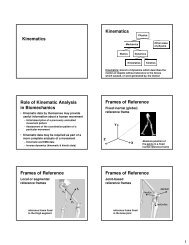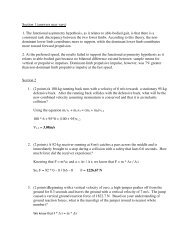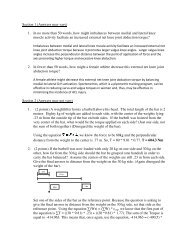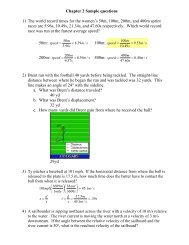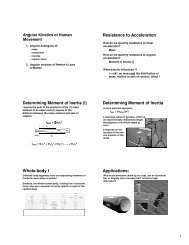Kinesiological Electromyography (EMG) Electromyography ...
Kinesiological Electromyography (EMG) Electromyography ...
Kinesiological Electromyography (EMG) Electromyography ...
Create successful ePaper yourself
Turn your PDF publications into a flip-book with our unique Google optimized e-Paper software.
Recording the <strong>EMG</strong><br />
Amplifier Common-Mode Rejection Ratio<br />
• CMRR is a measure of how well common<br />
signals are rejected in a differential set-up<br />
• CMRR of 1000:1 means all but 1/1000 of a<br />
common signal will be removed from recording<br />
• Minimally acceptable CMRR for <strong>EMG</strong><br />
– 10,000:1<br />
• Typical CMRR for commercial <strong>EMG</strong> amps<br />
– 20,000-100,00:1<br />
Recording the <strong>EMG</strong><br />
Amplifiers - a final note<br />
• <strong>EMG</strong> amps commonly have one or more<br />
hardware filters; these are analog filters that<br />
are applied before A/D conversion<br />
– High-pass filter - for removing movement artifact;<br />
common cutoff frequency of 10-20 Hz<br />
– Low-pass filter - to prevent aliasing during the A/D<br />
conversion process; common cutoff frequency of<br />
500-1000 Hz<br />
– Band-pass filter - equivalent to a high-pass followed<br />
by a low-pass filter<br />
Processing the <strong>EMG</strong><br />
A recorded <strong>EMG</strong> can be processed in<br />
numerous ways – some of the most common:<br />
– DC bias removal<br />
– Full-wave rectification<br />
– Linear envelope<br />
– Temporal analysis<br />
– Root-mean-square<br />
– Average amplitude<br />
– Peak amplitude<br />
– True mathematical integration<br />
– Frequency analysis<br />
– Amplitude normalization<br />
Processing the <strong>EMG</strong><br />
After data have been DC-bias corrected, full wave<br />
rectified, and possibly low-pass filtered, the two most<br />
common means for quantifying <strong>EMG</strong> signal strength are<br />
average amplitude and root mean square (RMS) value<br />
Average amplitude is the mean value of the rectified<br />
signal over a specified period of time, and represents the<br />
area under the curve for this time interval<br />
RMS value is the square root of the average power of the<br />
<strong>EMG</strong> signal over a specified period of time<br />
Processing the <strong>EMG</strong><br />
Amplitude Normalization<br />
• Many factors affect amplitude of <strong>EMG</strong> signal<br />
• There is little basis for comparing absolute<br />
<strong>EMG</strong> values across subjects, or even<br />
between muscles within a subject<br />
• Normalizing <strong>EMG</strong> signal amplitude to a<br />
reference condition improves validity of such<br />
comparisons<br />
– Data during trials are then expressed as a<br />
percentage of value from the reference condition<br />
Processing the <strong>EMG</strong><br />
Common Normalization References:<br />
– Maximal isometric voluntary contraction<br />
– Submaximal isometric voluntary contraction<br />
– Peak <strong>EMG</strong> amplitude during activity<br />
– Average <strong>EMG</strong> amplitude during activity<br />
Yang and Winter (1984) found the last two<br />
methods greatly reduced inter-subject<br />
variability, but at the expense of a<br />
meaningfulness of <strong>EMG</strong> amplitude<br />
6




